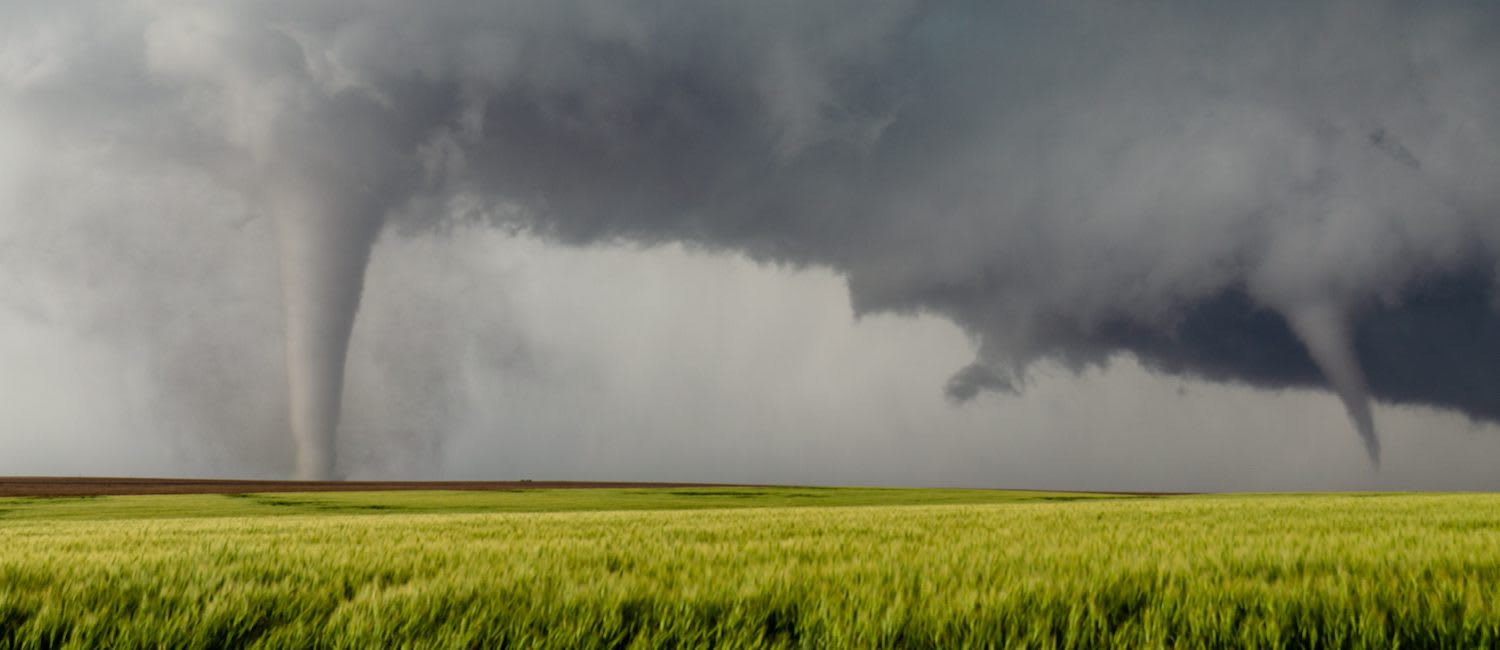Where To Go In a Top-Floor Apartment During a Tornado Warning

Emerging from afternoon thunderstorms, tornadoes usually include hail and high winds. This is why you need to take cover when the warning siren goes off. The problem is, the average apartment resident doesn’t have a basement at their disposal. So, what’s a renter to do in a top-floor apartment when there’s a tornado?
Tornadoes can happen anywhere
Tornadoes occur all over the world, but, “In terms of absolute tornado counts, the United States leads the list, with an average of over 1,000 tornadoes recorded each year,” according to the National Centers for Environmental Information.
The U.S. experiences tornadoes all over the country, but one particular area gets hit the hardest. Known as Tornado Alley, the area covers South Dakota, Nebraska, Kansas, Oklahoma, Northern Texas and Eastern Colorado. People who live in homes in these areas are more likely to have a storm shelter to take cover in.
Source: Accuweather
Whether you live in Tornado Alley or not, it’s important to always be weather aware. Tornado sirens, the National Weather Service and the local weather forecasters are helpful at telling people when a tornado is in the area, but there are some pretty obvious signs of a tornado. For example, the sky transforms into a dark, greenish mass and begins to roar like an oncoming train.
Just as you create a plan for many emergency situations, know where to shelter in your apartment during these destructive storms.
Can an apartment building survive a tornado?
On average, tornadoes move at speeds of about 10-20 miles per hour, and they often carry a lot of damaging debris. They rarely travel more than six miles, but that means they can still damage a whole section of town, from mobile homes to commercial buildings. For that reason, if a tornado is in your area, take shelter immediately.
Tornadoes come in a wide range of intensities, as explained by the Enhanced Fujita Scale of Tornado Intensity. Ranging from EF0 to EF5, strong winds start at 40 miles per hour and go upwards of 300 m.p.h.! Only the most intense tornadoes are likely to seriously damage an apartment building, however. Such a structure might suffer roof damage if an EF2 or above hits. Most tornadoes are simply not that strong, thankfully.
An EF4 or EF5 storm could easily cause deadly damage to an apartment complex, both of which can level or even carry away “well-constructed houses.” Fortunately for renters, the vast majority of apartment buildings are much larger than the average house, so it’s unlikely that an entire building would be completely destroyed, even if it is in a tornado’s path.
Is it better upstairs or downstairs during a tornado?
In a perfect world, everyone would have storm shelters to take cover in during a tornado outbreak or tornado threat. However, those are few and far between, and definitely lacking in apartment complexes. This is why it’s critical to have a shelter and safety plan in place before disaster strikes. An emergency kit or two doesn’t hurt, either!
While basements are not an option in all apartment buildings, get low if you can during a tornado. Heading to the basement or even the sub-level of an underground parking garage offers the most insulation against the weather.
If your building doesn’t have a basement, try to get to the lowest floor if you can, regardless of whether or not it’s at ground level or underground. Obviously, ground-floor or first-floor positioning is ideal. Shoot for the lowest floor possible in an interior, windowless room during a tornado watch or warning. This is a great opportunity to get to know your downstairs neighbors.
Even if no one answers the door at a ground-floor or first-floor apartment, there are other options. Interior stairwells or an interior hall are good alternatives during a natural disaster.
However, there’s not always a lot of time to go running downstairs, which brings us to our next point: never get on an elevator during a tornado warning! Loss of power could leave you trapped indefinitely, and therefore, at even higher risk. Tornados are notorious for pulling down power lines.
How do you survive a tornado in an upstairs apartment?
If you must stay upstairs during a tornado warning, choose the location wisely. Certain features are more dangerous during a twister with high winds. If underground or even the lowest floor aren’t options, opt for one of these alternative locations in your building.
Go to interior rooms
If a basement isn’t possible and tornado shelters aren’t practical, the next safest option during a tornado is any area fully inside the building. This means that the room should have no exterior walls. Under a stairwell, in an interior hallway or even in a room within your apartment can work. It helps to have as many walls as possible for protection.
However, make sure to choose a windowless area! Glass is the first thing to shatter, and causes many injuries by flying debris and broken glass shards.
Once you’re in the area, crouch down as low as you can get with your face down. Cover your head with your hands for extra protection or bring in a bike helmet to wear during the storm. If possible, get underneath a heavy table for added protection. Because of your location, there’s still a chance for décor to fall, so preventing head injury is important.
Take shelter in your bathroom
Even if they have an exterior wall or windows, bathrooms are safe because the thick pipes inside the walls insulate you during a tornado. In a pinch, climb into the bathtub if you have one and bring in your bed’s mattress to serve as a cover from debris falling. This is a good incentive to keep the bathroom nice and clean!
Use your closet
These are usually interior rooms by design, making closets a good choice to ride out a tornado. Plus, they have more space than the bathroom, usually. Bonus points if it’s a closet underneath stairs!
Pull your clothes off their hangers and heavy items off the shelves, so they don’t fall and cause injury. Grab bedding from the shelves to insulate yourself and protect yourself from falling objects. Make a cozy spot on the floor while you seek shelter. Don’t forget to close the closet door for even more protection.
Hit the closest stairwell
The stairwell in your building or parking garage is a great option to take cover. They’re usually an interior space without any windows. It also gives you easy access to exit the building and survey the damage when the tornado passes.
If your stairwell does have windows, you’ll need to stay away from those and be sure to take cover if the glass shatters.
Avoid dangerous areas in your apartment during a tornado
Tornadoes kill an average of 80 people each year. While knowing the safest places in your apartment during a tornado is certainly important, you should also know what areas to avoid when you take shelter.
Keep away from windows
With gusting winds strong enough to shatter glass, windows on exterior walls become dangerous during a tornado. Even worse, once a window breaks, all kinds of debris can blow inside. There’s no such thing as a safe window during a tornado!
If you can’t stay completely clear from windows during a tornado while you shelter, do your best to block them and protect yourself. If you can, duct tape a blanket over the window or slide a big piece of furniture in front to keep glass out of your apartment. If you absolutely must shelter in a room with a window, push a couch up against a wall and crouch there, or get under a heavy table. Those furniture pieces should help to minimize exposure to debris if the window shatters.
Stay clear of heavy objects
Some furniture pieces can actually be dangerous during a tornado. While it may seem like a good idea to slide under your bed or inch behind a heavy dresser for protection during a tornado, it’s not. These pieces of furniture can shift during a natural disaster, or even fall through the floor. You don’t want to get pinned under or against something so heavy you can’t move.
Prepare a tornado emergency kit
If you live in an area where tornado watches and warnings are common, consider creating a tornado emergency kit or two stocked with the right supplies to have on hand. The first kit can include items you’d need to easily exit your apartment after a tornado passes, such as:
- Portable radio
- Flashlight
- Extra batteries
- Cell phone charger
- Spare set of car and apartment keys
- Photocopy of your driver’s license
- Cash
Having these items ready can make it easier to evacuate your building after the tornado. Keep this kit in a closet or underneath the kitchen sink for easy access.
It’s also helpful to have other emergency supplies on hand when seeking shelter. Consider stowing the following in a designated spot in the closet where you can grab them quickly:
- First aid kit
- Sleeping bags
- Thick blankets
- Non-perishable snacks
- Bottled water
- Emergency radio
- Flashlight and batteries
The Boy Scouts are not wrong. It’s always better to be prepared, especially during a tornado warning!
Remaining safe after the tornado passes
Being safe doesn’t stop once the tornado has left the area. Dealing with the aftermath of this type of storm includes new dangers. Make sure to watch out for fallen or exposed utility lines, downed trees or limbs and falling debris.
If possible, shelter in place while the emergency teams do their job. Exercise extreme caution when leaving your apartment building. If enough there’s enough damage, you may have to stay out of your apartment. You may not see the dangers, so it’s important to wait for an official word before reentering. When you can, take pictures of any damage to your own property since you’ll most likely have to file a renters insurance claim.
Stay smart, seek shelter
Whether you wind up in the downstairs neighbor’s apartment, in a basement or in your own interior room closet, it’s absolutely possible to stay safe during a tornado warning. Follow our safety tips and remain calm throughout the experience. Hopefully, that twister will pass right on by without causing damage.




